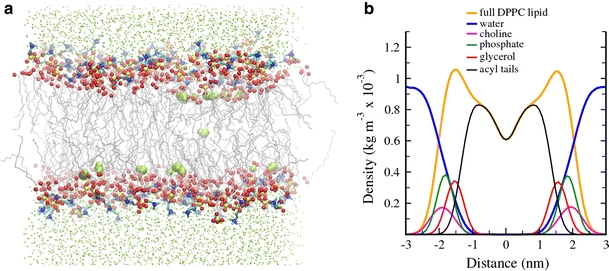Fig. 2.

Example of a simulated self-assembled and equilibrated DPPC lipid bilayer. The data correspond to a control MD simulation at 323 K reported by Esteban-Martín and Salgado (2007) a. Acyl chains of lipids are represented by gray lines, head-group atoms are balls colored red (oxygen) blue (nitrogen), and yellow (phosphorus); water is colored green, as small balls for molecules in typical hydrated regions, and as a CPK representation for molecules penetrating deeper (within a 20-Å center slab). Although lipid atoms tend to occupy confined positions as dictated by the hydrophobic effect and corresponding to the positional and orientational order of a smectic liquid-crystal phase, the bilayer is characterized by large spatial disorder. Notice, for example, the deeper penetration of some polar lipid head-groups and of a few water molecules. Furthermore, such positions are highly variable with time and are best described by broad distributions, represented in b. Although positions of water and polar groups reaching deep within the hydrocarbon region are of very low probability, they occur as transient states which can be the source of local thinning fluctuations and eventually facilitate pore formation. The distributions in b were calculated by averaging the latest 2 ns in the trajectory of the equilibrated self-assembled bilayer (20 ns after complete closure of the pore that forms during aggregation), while the picture in a corresponds to a selected frame within the same time range
